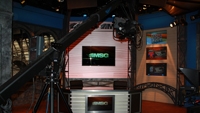MSG Networks spreads its wings

MSG Networks, the young upstart that transmitted its first live broadcast in 1969 and for the past 30 years has operated in makeshift facilities in and around the world famous Madison Square Garden arena in New York City, has moved into a new production studio and post facilities that would make its “big brother” colleagues proud.
No slouch, the network has eagerly worked its way through all of the various evolutions of analog and digital video technology over the years and was one of the first to produce and televise live HD games of the NBA Knicks and NHL Rangers (initially operating from a production truck parked outside in 1998). Yet, due to budget limitations and a years-long uncertainty of where its video production facilities should be located, it never had the showcase amenities large sports networks have typically enjoyed.
However, that “little brother” perception is about to change. Since October, the network has been operating from a new street-level studio, complete with new and legacy HD equipment and a new 3Gb/s infrastructure that can accommodate the highest-resolution HD and 3-D productions.
The new studio, transmission and editing facilities are located across the street from the Madison Square Garden Arena at 11 Penn Plaza, within the existing facilities of the company’s FUSE music video network. In fact, the studio is literally shared, and sets moved, with FUSE three or four days a week (schedule permitting). The post facilities and administration offices of FUSE are located on the second floor, while MSG Network’s new newsroom is on the third. It’s here that live and taped game content will be repurposed for the Internet and various mobile platforms.
“This gives us a really comfortable home we’ve never had before,” said Michael Mitchell, chief engineer at MSG Network and the one who oversaw the retrofit of the new studio. He not-so-fondly remembers the previous facilities, in the basement of MSG Arena, where “we never really knew what time of day it was because there were no windows.”
Mike Bair, president of MSG Media (the division operating the new facilities), called the former MSG Networks site “a rabbit’s nest.”
The studio was designed by Emmy Award-wining designer Keith Ray wood (who also did the current “Saturday Night Live” set) and retains an “old New York” feel, complete with faux steel girders and other accents that replicate the iconic ceiling of the MSG Arena and the interior of the original Pennsylvania Station.
The professional video industry's #1 source for news, trends and product and tech information. Sign up below.
“We love history here at MSG Networks, so it’s nice to be working from a space that exudes that feeling of old New York,” on-air anchor and long-time MSG Network employee Al Trautwig said. “And we’ll be sitting behind the desk, not walking around the set throwing a basketball like some other networks. New York sports fans are more sophisticated than other across the country, so we have an allegiance to them. This new studio does all that and a lot more. The entire staff is very excited to be working here. We feel like we have new jobs.”
The facility’s advanced connectivity counts its capabilities in miles — more than 60mi of fiber-optic cabling, 47mi of coax, 35mi of audio cables and 13mi of Ethernet cabling — which connects the staff throughout the FUSE building as well as those located across the street at the MSG Arena.
Within the entire building there are 18 Sony HD cameras with Canon HD lenses, two virtually identical control rooms (with Sony MVS-8000G switchers, Chyron HyperX graphics and Harris Centrio multiview monitor walls), two audio control rooms (with a Solid State Logic C132 audio console), a transmission control room (with 64 channels equipped with Harris frame synchronization and processing), a media operations room, 10 edit/post-production suites (Apple Final Cut Pro and Harris Velocity systems) and four central equipment rooms (three situated in-house and a fourth across the street).
There’s also Harris Platinum routers and modular signal processing gear to send the right signals to the correct destinations. The facility’s house format is XDCAM HD at 35Mb/s.
MSG Network’s experience with the 3-D hockey game was “positive,” said Gerry Passaro, senior vice president of network operations and distribution, but they won't try it again “until there’s real demand from fans, and right now, we’re not seeing it.”
“The best part of these new studios is that is puts all of our people under a singe roof,” Mitchell said. “I can’t tell you how important that is, because it fosters collaboration between staff members and gets content turned around quicker. We feel like the kid who’s finally moving out of his parents’ basement and getting his own place.”
